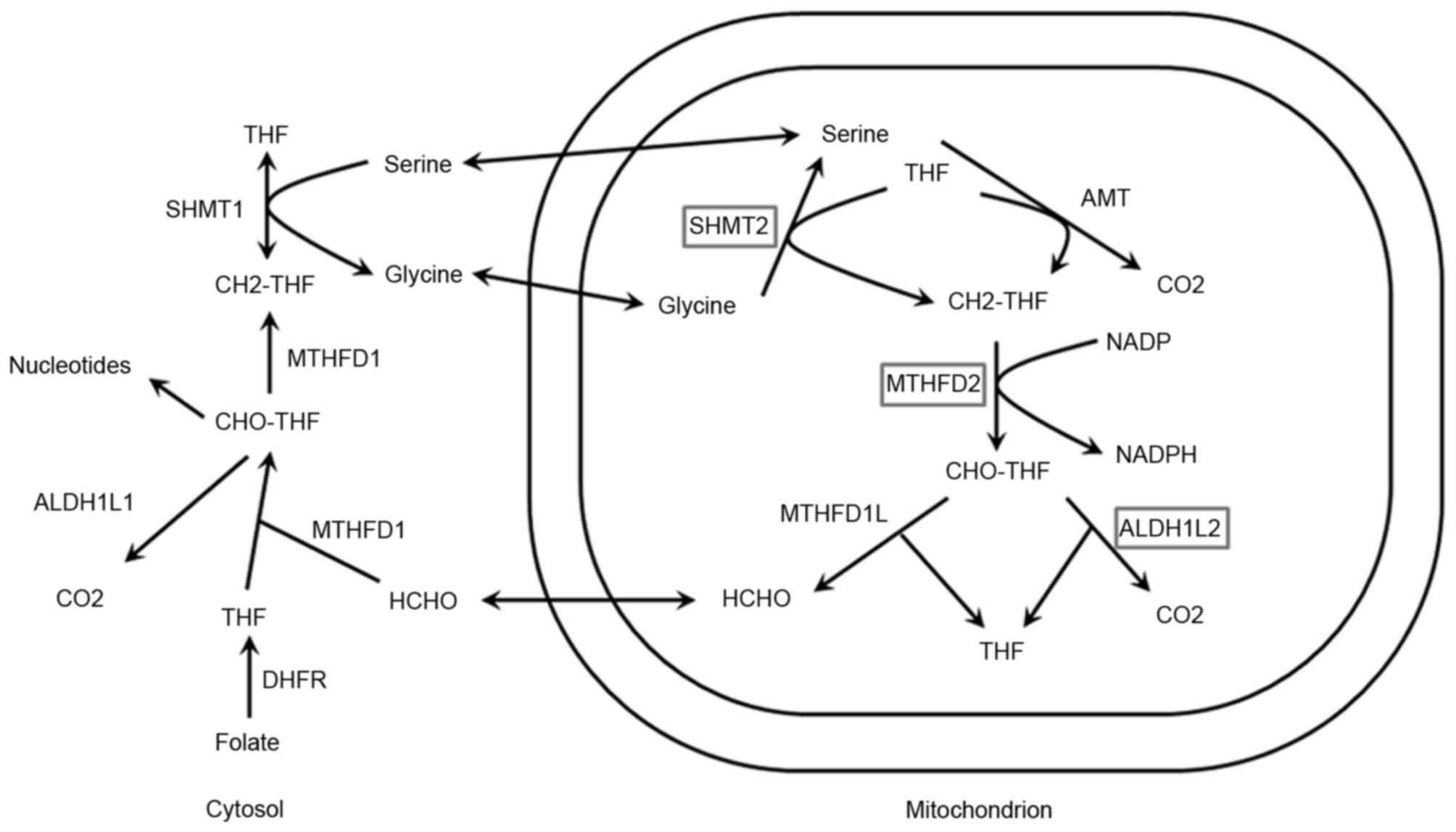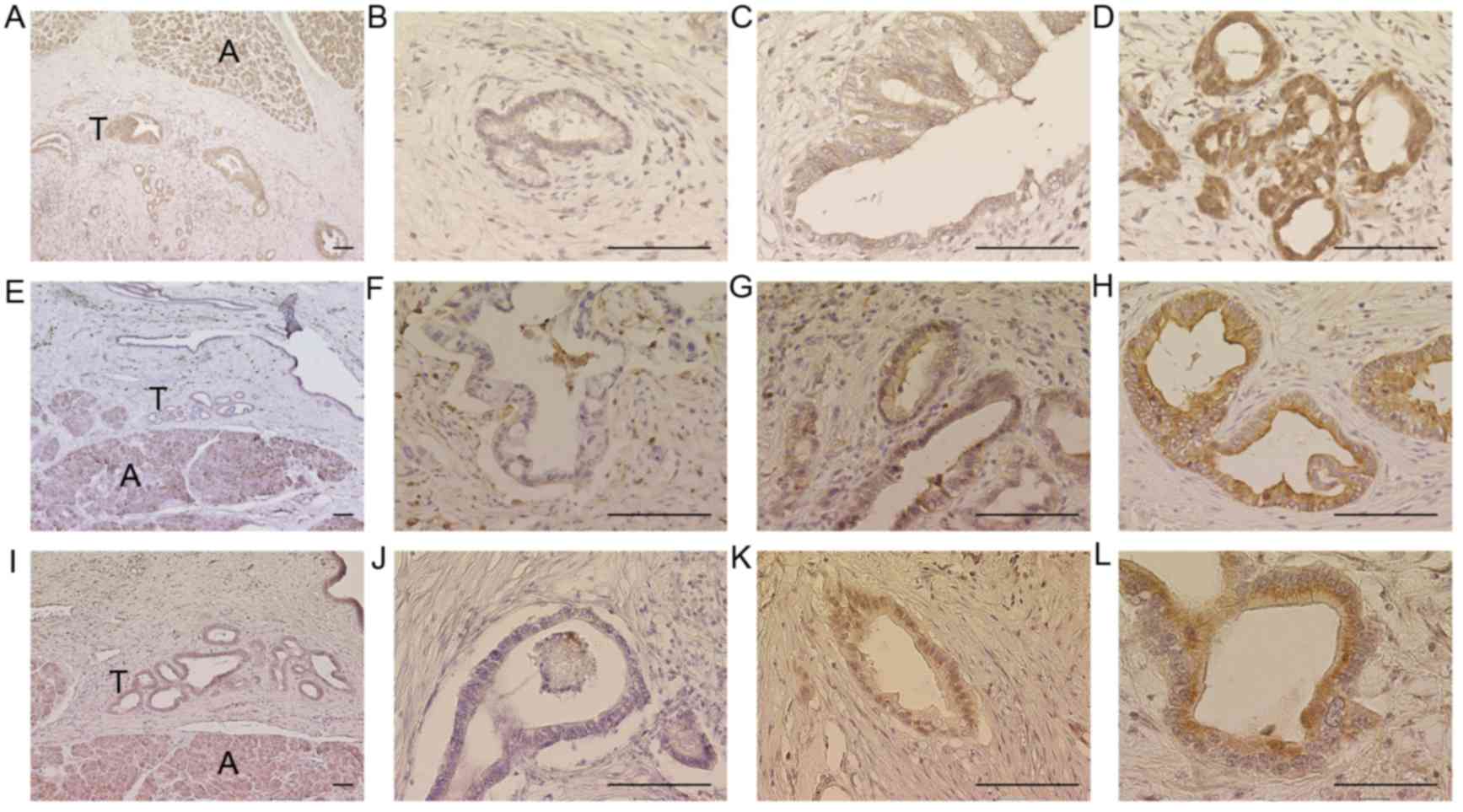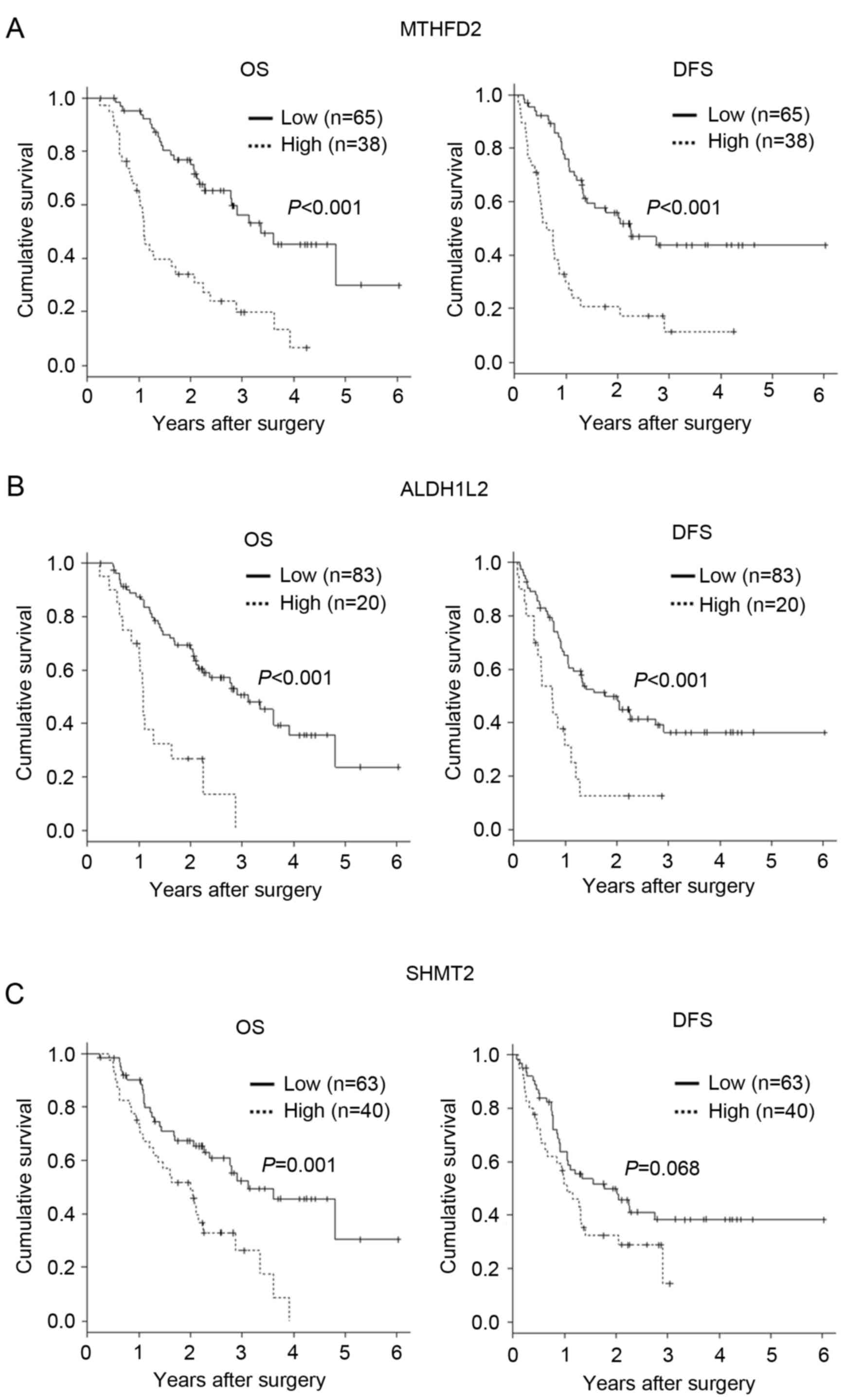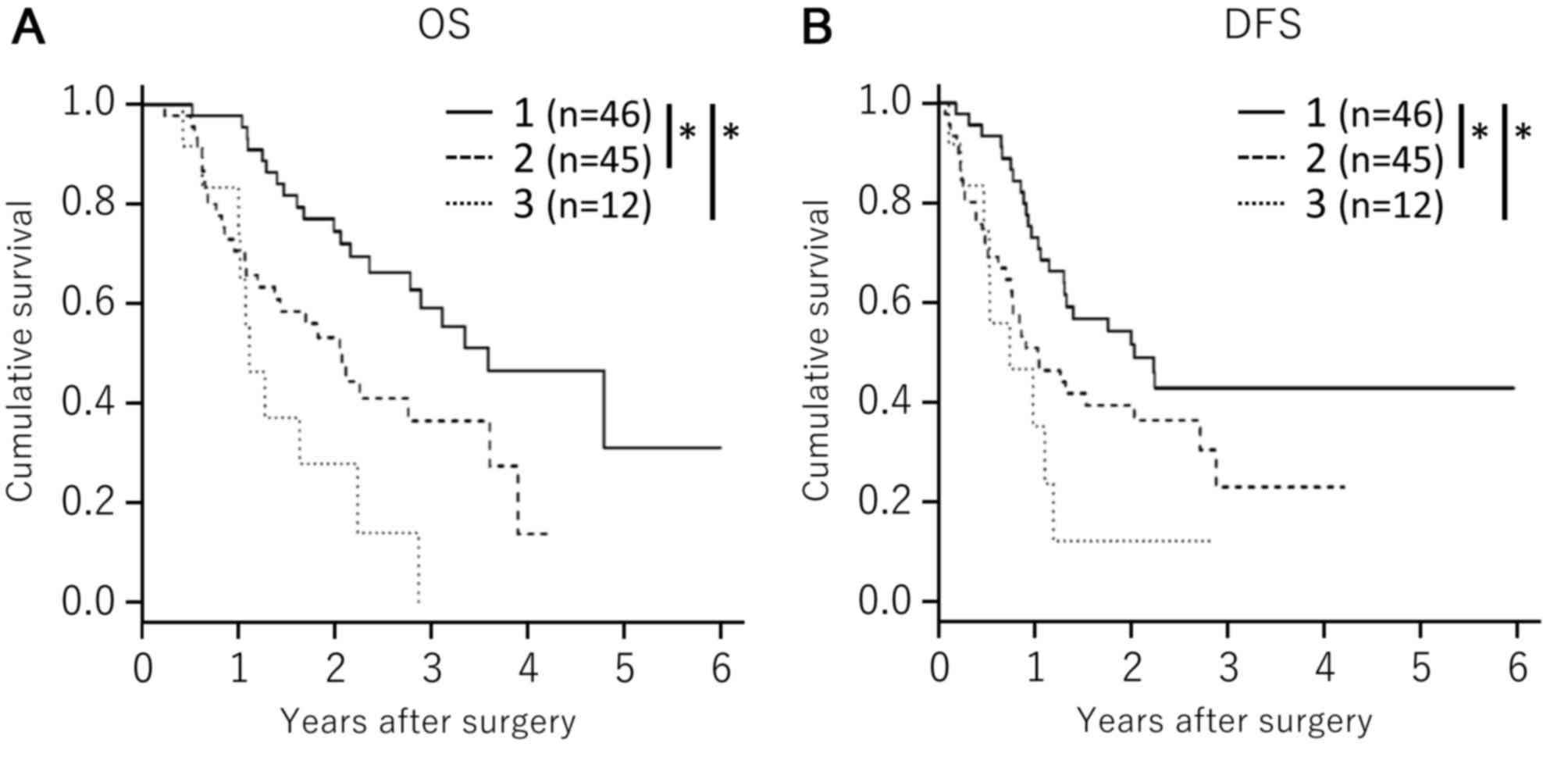The mitochondrial one‑carbon metabolic pathway is associated with patient survival in pancreatic cancer
- Authors:
- Published online on: May 24, 2018 https://doi.org/10.3892/ol.2018.8795
- Pages: 1827-1834
Abstract
Introduction
Pancreatic ductal carcinoma is the fourth most common cause of cancer-associated mortality in the United States of America (1). Despite recent advances in treatment modalities, the 5-year overall survival (OS) rate of pancreatic cancer patients is <5% (2), reflecting the aggressive invasion and early metastasis of the disease; the presence of extra-pancreatic dissemination at diagnosis is typical for patients with pancreatic cancer (3–5). Although a number of molecules have been identified to serve roles in the progression and metastasis of pancreatic cancer, the underlying molecular mechanisms remain unclear.
One-carbon metabolism is a network of biological reactions that serve critical roles in DNA methylation and DNA synthesis, and facilitate cross talk between genetic and epigenetic processes (6) (Fig. 1). One-carbon metabolism is also referred to as folate-mediated one-carbon metabolism and can impact genetic and epigenetic pro-carcinogenic processes, reflecting critical roles in DNA methylation and DNA synthesis. Methylenetetrahydrofolate dehydrogenase 2 (MTHFD2) is an enzyme of the mitochondrial folate metabolic pathway that functions as a methylenetetrahydrofolate dehydrogenase and a cyclohydrolase (6). Previous studies demonstrated that MTHFD2 was specifically upregulated in various types of cancer, compared with in normal tissues, and MTHFD2 has been identified as a novel drug target with the potential to block cancer cell migration and invasion in breast cancer and melanoma (7,8). In the present study, the expression of MTHFD2 and the coupling enzymes aldehyde dehydrogenase 1 family member L2 (ALDH1L2) and serine hydroxymethyltransferase (SHMT2), and the clinicopathological significance of these mitochondrial folate metabolic pathway enzymes in pancreatic cancer were investigated.
Materials and methods
Patients and specimens
Between April 2007 and December 2013, a total of 103 patients underwent surgical resection for pancreatic ductal adenocarcinoma (PDAC) at the Department of Surgery at Osaka University Hospital (Osaka, Japan) and all patients were enrolled in the present study (mean age, 67.2±9.6, range 38 to 84 years; 64 males and 39 females; Table I). The clinicopathological characteristics of the enrolled patients are presented in Table I. Patients who underwent preoperative chemotherapy were included in this study. The tumor stages were determined according to the 7th edition of the American Joint Committee on Cancer/Unio Internationalis Contra Cancrum (UICC) tumor-node-metastasis classification (9). Two pathologists examined all histological slides, and the immunohistochemical (IHC) diagnoses of tumors and degrees of differentiation were determined. The median follow-up time was 60.9 months (range, 2 to 72 months), and the regular follow-up included measurements of carcinoembryonic antigen (CEA) and carbohydrate 19-9 (CA19-9). The present study was approved by an institutional review board of Osaka University School of Medicine (approved by Professor Y. Kaneda) and written informed consent was provided by all patients.
Immunohistochemistry
IHC analyses were performed as described previously (10). Briefly, surgical tissue specimens were fixed in 10% formaldehyde, embedded in paraffin and cut into 3.5-µm sections. The sections were then deparaffinized in xylene, incubated at 95°C for 10 min with antigen retrieval buffer (cat no. CTS014; Funakoshi Co., Ltd., Tokyo, Japan) and then incubated with the following specific antibodies overnight at 4°C: Anti-MTHFD2 (cat no. ab176016; rabbit polyclonal; dilution, 1:100), anti-ALDH1L2 (cat no. ab170176; rabbit polyclonal; dilution, 1:200) or anti-SHMT2 (cat no. ab64417; rabbit polyclonal; dilution, 1:300; all Abcam, Cambridge, MA, USA). The sections were subsequently visualized using avidin-biotin complex reagents by direct addition (no dilution; ABC-HRP kit; Vector Laboratories, Inc., Burlingame, CA, USA) and diaminobenzidine. The reaction was performed for 30 min at 23°C. Two reviewers performed IHC analyses independently in a blinded manner. All IHC analyses were performed using a series of tissue sections for each antibody.
Quantification of immunostaining parameters
IHC analyses of MTHFD2, ALDH1L2 and SHMT2 were performed at ×200 magnification using a light microscope. The samples were scored according to the intensity of cytoplasmic staining for MTHFD2 and were categorized as follows: 0, no staining; 1, weak (weaker staining than the positive control); 2, strong (equal to or stronger than the positive control, which included advanced colorectal cancer tissues or normal pancreatic acini tissues). IHC analyses of ALDH1L2 and MTHFD2 were scored in the same manner. The positively stained cells were counted in four representative fields of tumor regions at ×100 magnification. Patients with scores of 1 or 0 were included in the low expression group and those with scores of 2 were included in the high expression group.
Statistical analysis
The associations between MTHFD2, ALDH1L2 and SHMT2 expression levels and other parameters were identified using chi-squared tests, Fisher's exact tests or independent t-tests as appropriate. The OS and disease-free survival (DFS) rates were estimated using the Kaplan-Meier estimator method and were compared using the log-rank test. Variables that were identified as significant in univariate analyses were included in subsequent Cox proportional hazards regression models. All statistical analyses were performed using JMP Statistical Software (version 11; SAS Institute Inc., Cary, NC, USA). P<0.05 was considered to indicate a statistically significant difference.
Results
IHC analyses of one-carbon metabolism enzymes in PDAC
The clinicopathological characteristics of the patients included in the current study are presented in Table I. IHC analysis demonstrated that MTHFD2, ALDH1L2 and SHMT2 were localized in the cytoplasm of pancreatic cancer cells (Fig. 2). In addition, MTHFD2 expression was greater in pancreatic epithelial cancer tissue specimens compared with in surrounding non-epithelial tissues (Fig. 2). Representative images of ALDH1L2 scoring are demonstrated as: Score 0 in Fig. 2A, score 0 in Fig. 2B, score 2 in Fig. 2C, and score 2 in Fig. 2D. Examples of MTHFD2 scoring are presented as: Score 0 in Fig. 2E, score 1 in Fig. 2F, score 2 in Fig. 2G, and score 2 in Fig. 2H. Representative SHMT2 scoring is demonstrated as: Score 0 in Fig. 2I, score 1 in Fig. 2J, score 2 in Fig. 2K, and score 2 in Fig. 2L. With the exception of pathological N stage, no significant differences were observed in the clinicopathological parameters between the high and low expression groups in all three enzymes (data not presented). High MTHFD2 expression was positively correlated with the incidence of lymph node metastases (P=0.033; data not presented). IHC analyses using advanced colorectal cancer tissues or normal pancreatic acini tissues were used as positive controls as observed by two pathologists. Following IHC analyses of MTHFD2, ALDH1L2 and SHMT2, patients with scores of 1 or 0 were included in the low expression group and those with scores of 2 were included in the high expression group (Fig. 2).
Expression of MTHFD2, SHMT2 and ALDH1L2 in patients with PDAC correlates with poor outcomes
A previous report correlated the expression of the mitochondrial folate metabolic pathway enzyme MTHFD2 with poor clinical survival in breast cancer (7). Thus, we determined the association of mitochondrial folate metabolic pathway enzymes, including MTHFD2, ALDH1L2 and SHMT2, with clinical survival in patients with pancreatic cancer using Kaplan-Meier estimator analyses. Kaplan-Meier estimator curves demonstrated significantly lower DFS among patients with high tumor MTHFD2 expression (P<0.001; Fig. 3A). In addition, high ALDH1L2 expression was significantly associated with poor OS and DFS (P<0.001; Fig. 3B). SHMT2 expression was significantly associated with poor OS (P=0.001), but was not associated with DFS (P=0.068; Fig. 3C). These data suggest that one-carbon metabolism serves an important role in the biologically malignant features such as invasion and metastasis of pancreatic cancer. In addition, based on the univariate analysis of OS (Table II), clinicopathological features that correlated with poor patient survival included pathological N stage (P<0.001), pathological UICC stage (P=0.007) and IHC scores for MTHFD2 (P<0.001), ALDH1L2 (P<0.001) and SHMT2 (P=0.002). Subsequent multivariate Cox proportional hazards analyses revealed that pathological N stage and IHC scores for MTHFD2, ALDH1L2 and SHMT2 were independent prognostic factors for OS (P=0.001, P=0.015 and P=0.017, respectively). Similarly, based on the univariate analyses of DFS (Table III), clinicopathological features that correlated with poor patient survival included pathological N stage (P<0.001), pathological UICC stage (P=0.034) and IHC scores for MTHFD2 (P<0.001) and ALDH1L2 (P<0.001); however, SHMT2 expression was not associated with patient survival (P=0.070). Finally, multivariate Cox proportional hazards analyses demonstrated that pathological N stage and IHC scores for MTHFD2 are independent prognostic factors for OS (P=0.025 and P<0.001, respectively).
Low expression of MTHFD2, SHMT2 and ALDH1L2 correlates with improved survival among patients with PDAC
Overexpression of MTHFD2, SHMT2 or ALDH1L2 was associated with poor survival (Fig. 3); however, it remains unclear whether the upregulation of one folate metabolic pathway enzyme directly enhances another folate pathway. As tumors that depend on the folate metabolic pathway may upregulate multiple folate metabolic pathway enzymes for progression and survival, the clinical outcomes of patients with PDAC with high expression of all three enzymes were compared with those of patients with low expression of all three enzymes, or with high expression of one or two of the enzymes. Kaplan-Meier estimator analyses revealed that low expression levels of MTHFD2, ALDH1L2 and SHMT2 correlated with improved OS and DFS in patients with PDAC, as compared with in patients with high expression of one or two of the enzymes (P<0.001; Fig. 4).
Discussion
In the present study, overexpression of each of the one-carbon metabolic enzymes, MTHFD2, ALDH1L2 and SHMT2, which are specifically located in the mitochondria, was associated with poor clinical outcomes among patients with PDAC. However, high and low expression levels of all three folate pathway enzymes were associated with improved survival, compared with the high expression of one or two of the three enzymes studied. Previously, a high intake of folate and the upregulation of the folate pathway were considered to reduce the risks of cancer due to the associated antioxidant activities of the folate metabolic pathway (6). However, recent epidemiologic data regarding the association between folate intake and pancreatic cancer are inconsistent (11). In addition, the expression of folate metabolic pathway enzymes, including MTHFD2, was identified to be markedly elevated in numerous types of cancer (12) and MTHFD2 expression has previously been associated with poor clinical outcomes (7). Therefore, one-carbon metabolism is currently considered one of the most important metabolic pathways for cancer progression (6).
Previous studies have revealed a number of molecular mechanisms underlying the effects of the folate metabolic pathway on tumorigenesis and metastasis (6). As a source of one-carbon units that are necessary for DNA replication and repair, folate protects normal tissues from mutations and chromosomal damage. However, folate may enhance the growth of pre-existing neoplastic lesions, as rapidly proliferating tissues such as tumors have increased nucleotide demands. Additionally, antioxidants have been demonstrated to promote distant metastasis in immunodeficient mice, and the inhibition of the folate pathway using low-dose methotrexate, ALDH1L2 knockdown or MTHFD1 knockdown limited distant metastasis without significantly affecting the growth of subcutaneous tumors in mice. Therefore, oxidative stress inhibits the distant metastasis of melanoma cells in vivo (8).
In the present study, the systematic downregulation of individual folate metabolic pathway enzymes was demonstrated to significantly correlate with improved survival. Recently, innovative drugs have been developed that target one-carbon metabolism. However, the majority of drugs targeted dihydrofolate reductase (DHFR). When the DHFR enzyme was inhibited, there was a metabolic flow of one-carbon metabolism. Therefore, the effect of DHFR targeting drugs may be insufficient. Cytoplasmic one-carbon metabolic enzymes, including MTHFD1, ALDH1L1 and SHMT1, and mitochondrial enzymes, including MTHFD2, ALDH1L2 and SHMT2, constitute the circinate metabolic flow, and this metabolic flow does not have an alternative loophole pathway. Therefore, the effect of targeting these enzymes may be sufficient. However, normal pancreatic tissues have high expression levels of these one-carbon metabolic enzymes. Thus, the drug targeting these enzymes must be delivered using cancer-specific drug delivery systems. Specifically, data from the present study demonstrated that high expression levels of one or two of the enzymes MTHFD2, ALDH1L2 and SHMT2 are associated with poor prognosis (Figs. 3 and 4), suggesting that the activity of one carbon metabolism plays a role in invasion and metastasis of pancreatic cancer cells and associates with clinical survival of patients with pancreatic cancer. These proteins may be independent prognostic factors and potential therapeutic targets for pancreatic cancer.
Acknowledgements
Not applicable.
Funding
The present study was supported in part by a Grant-in-Aid for Scientific Research from the Ministry of Education, Culture, Sports, Science and Technology (Tokyo, Japan; grant nos. 23390199, 25112708, 25134711, 30253420 and 26670604), a Grant-in-Aid from the Ministry of Health, Labour and Welfare (Tokyo, Japan; grant no. H23-003), a grant from the National Institute of Biomedical Innovation (Osaka, Japan; grant no. 12-4) and a grant from the Osaka University Drug Discovery Fund (Osaka, Japan). Partial support was also received from the Takeda Science and Medical Research Foundation (Osaka, Japan; to Dr H Ishii), the Princess Takamatsu Cancer Research Fund (Tokyo, Japan; to Dr H Ishii), the Suzuken Memorial Foundation (to Dr M Konno), the Yasuda Medical Foundation (to Dr M Konno), the Pancreas Research Foundation (to Dr K Kawamoto), the Nakatani Foundation (to Dr H Ishii) and the Nakatomi Foundation, Japan (to Dr M Konno).
Availability of data and materials
The datasets used and/or analyzed during the current study are available from the corresponding author on reasonable request.
Authors' contributions
KN, MK, HE, YD, MM, and HI conceived and designed the study. KN, MK and HI developed the methodology. KN, MK, JK, NN, KK, DY, TA, TN, HW, KG, DS, TK, TS, HE and HI acquired the data. KN, MK, JK, NN and KK analyzed and interpreted the data. KN, MK, HE, YD, MM and HI wrote, reviewed and revised the manuscript. MM and HI supervised the study.
Ethics approval and consent to participate
This study has been approved by the research ethics committee of Osaka University (ID of the approval: 15149-2, by Dr. Y. Kaneda).
Consent for publication
All patients provided written consent for the publication of results.
Competing interests
Institutional endowments were received partially from Taiho Pharmaceutical Co., Ltd. (Tokyo, Japan), Evidence-Based Medical Research Center (Osaka, Japan), Chugai Co., Ltd. (London, UK), Yakult Honsha Co., Ltd. (Tokyo, Japan) and Merck & Co., Ltd., Whitehouse Station, NJ, USA). These funding bodies had no role in the main experimental equipment, the study design, data collection and analysis, the decision to publish or the preparation of this manuscript.
References
|
Howe HL, Wu X, Ries LA, Cokkinides V, Ahmed F, Jemal A, Miller B, Williams M, Ward E, Wingo PA, et al: Annual report to the nation on the status of cancer, 1975–2003, featuring cancer among U.S. Hispanic/Latino populations. Cancer. 107:1711–1742. 2006. | |
|
Majumder K, Gupta A, Arora N, Singh PP and Singh S: Premorbid obesity and mortality in patients with pancreatic cancer: A systematic review and meta-analysis. Clin Gastroenterol Hepatol. 14:355–368.e. 2016. View Article : Google Scholar : PubMed/NCBI | |
|
Hashimoto D, Chikamoto A, Ohmuraya M, Sakata K, Miyake K, Kuroki H, Watanabe M, Beppu T, Hirota M and Baba H: Pancreatic cancer in the remnant pancreas following primary pancreatic resection. Surg Today. 44:1313–1320. 2014. View Article : Google Scholar : PubMed/NCBI | |
|
Kanda M, Fujii T, Takami H, Suenaga M, Inokawa Y, Yamada S, Nakayama G, Sugimoto H, Koike M, Nomoto S and Kodera Y: Combination of the serum carbohydrate antigen 19-9 and carcinoembryonic antigen is a simple and accurate predictor of mortality in pancreatic cancer patients. Surg Today. 44:1692–1701. 2014. View Article : Google Scholar : PubMed/NCBI | |
|
Pandol S, Gukovskaya A, Edderkaoui M, Dawson D, Eibl G and Lugea A: Epidemiology, risk factors, and the promotion of pancreatic cancer: Role of the stellate cell. J Gastroenterol Hepatol. 27(Suppl 2): S127–S134. 2012. View Article : Google Scholar | |
|
Konno M, Asai A, Kawamoto K, Nishida N, Satoh T, Doki Y, Mori M and Ishii H: The one-carbon metabolism pathway highlights therapeutic targets for gastrointestinal cancer (Review). Int J Oncol. 50:1057–1063. 2017. View Article : Google Scholar : PubMed/NCBI | |
|
Liu F, Liu Y, He C, Tao L, He X, Song H and Zhang G: Increased MTHFD2 expression is associated with poor prognosis in breast cancer. Tumour Biol. 35:8685–8690. 2014. View Article : Google Scholar : PubMed/NCBI | |
|
Piskounova E, Agathocleous M, Murphy MM, Hu Z, Huddlestun SE, Zhao Z, Leitch AM, Johnson TM, DeBerardinis RJ and Morrison SJ: Oxidative stress inhibits distant metastasis by human melanoma cells. Nature. 527:186–191. 2015. View Article : Google Scholar : PubMed/NCBI | |
|
Edge SB, Byrd DR, Compton CC, Fritz AG, Greene FL and Trotti A: AJCC cancer staging manual 7. Springer; New York, NY; 2010 | |
|
Hasegawa S, Eguchi H, Nagano H, Konno M, Tomimaru Y, Wada H, Hama N, Kawamoto K, Kobayashi S, Nishida N, et al: MicroRNA-1246 expression associated with CCNG2-mediated chemoresistance and stemness in pancreatic cancer. Br J Cancer. 111:1572–1580. 2014. View Article : Google Scholar : PubMed/NCBI | |
|
Lin HL, An QZ, Wang QZ and Liu CX: Folate intake and pancreatic cancer risk: An overall and dose-response meta-analysis. Public Health. 127:607–613. 2013. View Article : Google Scholar : PubMed/NCBI | |
|
Nilsson R, Jain M, Madhusudhan N, Sheppard NG, Strittmatter L, Kampf C, Huang J, Asplund A and Mootha VK: Metabolic enzyme expression highlights a key role for MTHFD2 and the mitochondrial folate pathway in cancer. Nat Commun. 5:31282014. View Article : Google Scholar : PubMed/NCBI |













